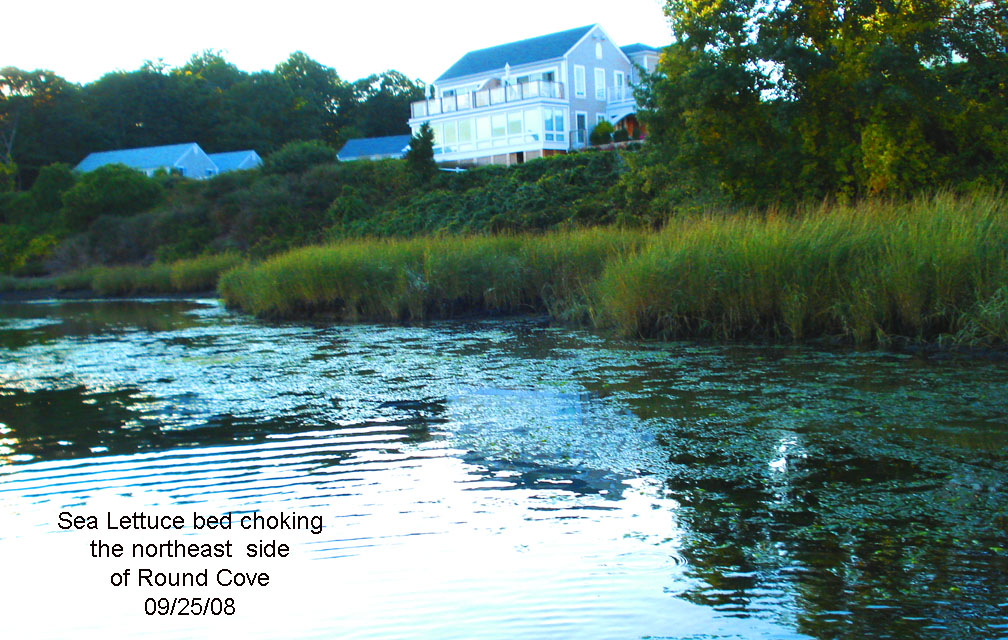

 | |
| The sea lettuce manage project will be a cooperative effort between the Harwich Natural Resources Department and the Harwich commercial shellfishermen. We will be monitoring positive and negative impacts of removing a large quantity of the plant from the embayment. The small size of the Round Cove may lend itself to making a measurable change in the level of dissolved oxygen, and nitrate. |
These large mats of algalflora rob the Cove of oxygen through the process of respiration. In addition, as this weed expires, the decaying material releases nitrogen back into the water. This is a natural cycle; however, Round Cove is an ideal habitat for Sea Lettuce and therefore Ulva has thrived. We believe a significant increase in nitrogen loading has occurred causing the algae to bloom and the water quality in Round Cove to decline. A report by the Cape Cod Commission entitled Harwich Coastal Embayment Project found that "nitrogen from land use within the watersheds to Round Cove and a portion of Allens Harbor (referred to as "Allens Harbor (arm)") currently exceed the critical nitrogen loading limits of these embayments".
Need for Technology
The Massachusetts Division of Marine Fisheries has been contacted and they know of no documented work describing the result of Sea Lettuce harvest from a small body of water. They have given us their support and expressed interest in the result from our study. Although this would be the first full-scale attempt to correct the Ulva lactuca problem, a pilot-study was previously carried out on a very small section in Round Cove. It was determined that the Sea Lettuce was easily harvested by hand and that it did not re-establish itself quickly.
Procedure
A combined effort between the Natural Resources Department and the Harwich Commercial Shellfishermen has been planned to combat the Round Cove Sea Lettuce problem. Shellfishermen will be issued fish totes/bins and while they harvest quahogs the unavoidable Sea Lettuce they encounter will be removed, placed into the bins, and disposed by Natural Resources personnel.
Methodology and Data Collection
To determine quantitatively the success of our plan, dissolved oxygen and secchi disk (turbidity parameter) readings will be taken prior to any Sea Lettuce removal. An estimate of the existing crop of Ulva will be determined and a record will be kept on the amount/volume of Sea Lettuce removed as well as changes in the dissolved oxygen and turbidity in Round Cove. It is the Natural Resources Department intent to create a cleaner, healthier environment for all organisms within Round Cove. Round Cove serves as an important shellfish propagation area for juvenile seed clams and is one of the few areas in Harwich where both recreational and commercial shellfishermen can harvest shellfish.
Follow-up
The Natural Resources Department will follow-up this project with reports on condition of the bed in two month intervals to determine the success of the project and report these findings to the Harwich Conservation Commission and the Division of Marine Fisheries along with recommendations for the future.
Test Wells
In light of the findings of the Harwich Coastal Embayment Project, The Shellfish and Marine Water Quality Committee would like to see four test wells placed at strategic locations along the shore line of the Round Cove above MHW. Samples would be drawn from these wells as well as from stations in the Cove to determine levels of nitrogen/phosphate to formulate a scientific opinion on eutrophication.
Notification
All abutters have been notified and unless there is reason to reevaluate our plan, the Natural Resources Department along with the Commercial Shellfishermen are poised and ready to proceed.

